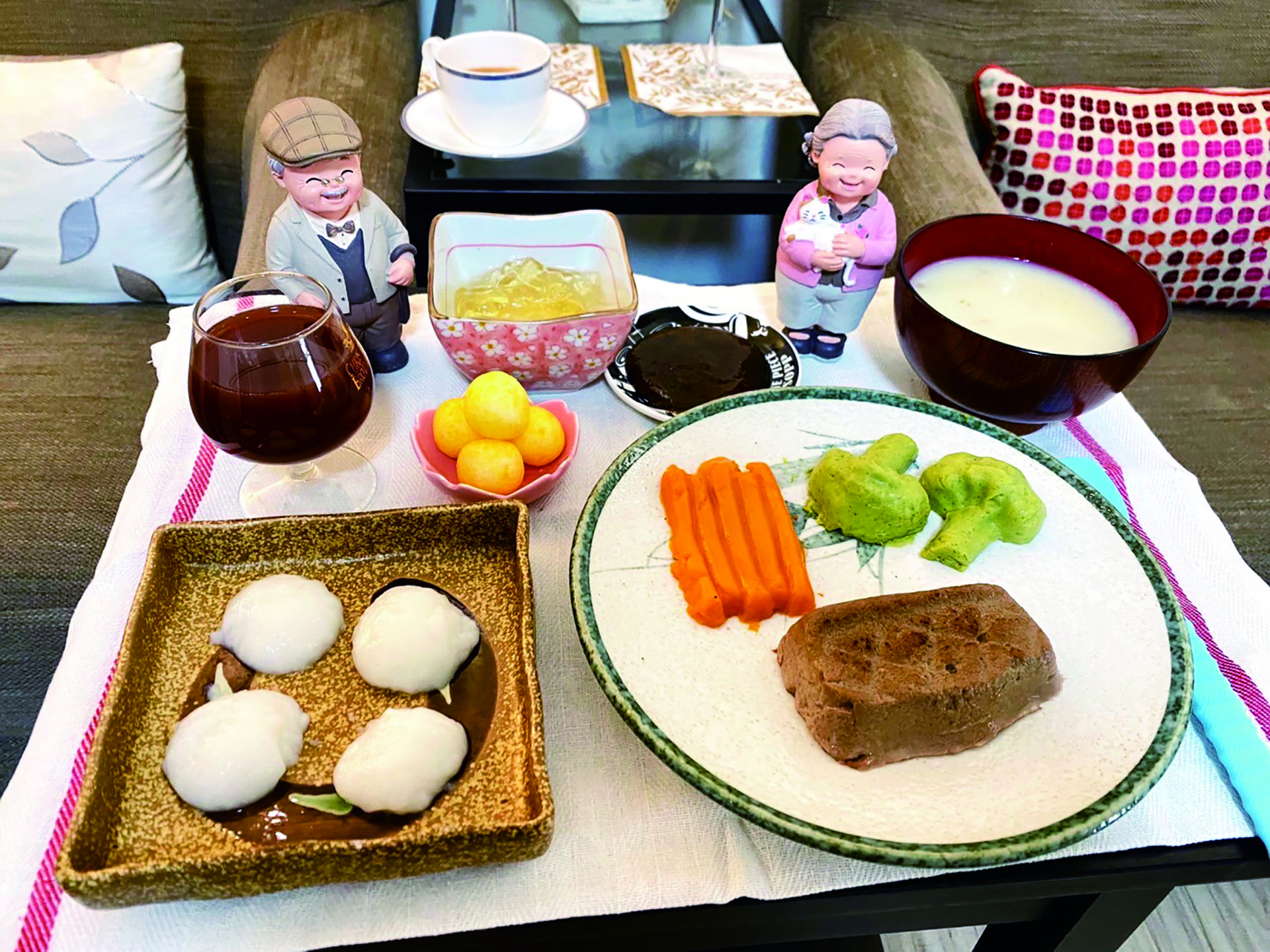Chewing, swallowing, and enjoying food constitute a significant joy in life. However, when factors like aging, stroke, dementia, or terminal illness impede a person's ability to swallow, balancing life-sustaining nutrition while preserving the joy of eating by mouth becomes the wish of many patients and a deeply distressing challenge for their families.
"Grandma is willing to open her mouth to eat!" The daughter was overjoyed seeing her 95-year-old Grandma Zhang successfully have her nasogastric tube removed, reclaiming the ability to eat by mouth and even speak. She had not anticipated that, through the collaborative efforts of a speech therapist, a dietitian, a home doctor, and a nurse practitioner, the nasogastric tube could be removed within just two months. Moreover, her mother could now join the family for meals outside the home.
Grandma Zhang, who suffered from severe dementia, was hospitalized due to shock during the Chinese New Year. She subsequently developed aspiration pneumonia and required a nasogastric tube. Uncomfortable by the presence of the tube, she frequently removed it on her own. Witnessing her distressing actions, her family felt deeply saddened and anxious, fearing she might be confined to a bedridden life dependent on tubes. Hoping to restore her ability to eat by mouth, they sought the assistance of Ms. Hsueh-Pei Wang, a therapist and the director of Enjoy Swallowing and Speech Clinic.
"Due to her prolonged struggle with dementia, Grandma Zhang seldom speaks and, being hospitalized for an extended duration, she's developed a strong sense of defensiveness. When encountering unfamiliar faces, she becomes highly anxious, keeping her mouth tightly shut. Despite her silence, she emits throaty purring sounds." After Director Wang's assessment, tailored strategies were devised and gradually implemented. Eventually, Grandma Zhang transitioned from consuming only thickened or frozen liquids to eating shaped meals. Remarkably, within a month and a half, she progressed to the point where the nasogastric tube could be removed.
Following that, Grandma Zhang's swallowing training progressed to the extent that she could consume home-cooked soft meals. "With her family's assistance and meticulous meal preparations, she was able to revert to her former lifestyle," Director Wang mentions. What's truly remarkable is the improvement in Grandma's cognitive abilities—her speech capabilities have surpassed her pre-hospitalization state. Not only does she engage more actively with others, but she also initiates conversations and inquiries. As a result, her family can now take her out for meals together.
Eating Comfortably Is of Greater Importance than Deciding Whether to Remove the Nasogastric Tube
Numerous terminally ill patients encountering swallowing difficulties may eventually confront the need for a nasogastric tube due to inadequate nutritional intake or the risk of aspiration pneumonia. During this period, their families often grapple with a challenging dilemma. They yearn for their elders to enjoy beloved foods in the twilight of their lives while simultaneously worrying about the heightened risk of aspiration pneumonia if the nasogastric tube isn't inserted. This dual concern renders the decision of whether or not to proceed with the NGT insertion exceedingly challenging.
Drawing from over a decade of experience as a nurse and speech therapist, Director Wang reassured Grandma Zhang's family that even if an elderly individual opts for home care with a nasogastric tube, they can still engage a speech therapist to facilitate oral feeding if the desire to eat persists. This doesn't mean the complete cessation of mouth feeding once the tube is inserted. "Our aim in assisting terminally ill patients with oral feeding is to ensure that elderly individuals receiving home hospice care can eat comfortably, preserving their dignity," she emphasizes.
The concept of comfortable eating aims to provide dementia or terminally ill patients with swallowing difficulties the choice to eat orally when they desire, and the option to abstain or use alternative methods (like gastrostomy or IVs, etc.) when they don't wish to eat. This approach transforms eating into a form of enjoyment. There exists a wide array of methods and tools, and as a speech therapist, Director Wang begins the intervention by asking the patient, "What do you most want to eat?" Once the patient's favorite food is identified, she determines a safe texture that aligns with the patient's swallowing ability. For instance, steak can be transformed into a soft steak that gently dissolves when chewed by the gums, or a frozen steak that dissolves when pressed against the palate (see picture). If the patient desires beer but faces difficulties with water due to choking, she prepares thickened beer that maintains its delightful bubbly texture!

Once the patient's favorite foods are established, the next step involves aligning these preferences with their swallowing abilities to identify a texture that not only caters to their tastes but also ensures safety in consumption. This might involve options like frozen shaped steak or thickened beer that retains its effervescence.
Eating or feeding techniques are personalized, with speech therapists instructing caregivers on safe feeding methods. For promising patients, therapists gradually train and improve their swallowing functions.
"Speech Therapists" Helping Patients Rediscover the Pleasure of Eating
The role of a speech therapist, in essence, involves assessing and discussing the needs of the patient and their family, offering assistance in swallowing training, speech rehabilitation, dietary guidance, and caregiver education. “Simultaneously, evaluations are tailored based on the family's caregiving capabilities, and the training goals sometimes focus on reducing the risk of aspiration pneumonia,” Director Wang describes the support speech therapists provide for terminally ill patients in home care under Long-Term Care 2.0.
In the past, families seeking the assistance of a speech therapist through medical units often required a referral from one department to another, typically from the original department to the rehabilitation unit. However, under the current Long-Term Care 2.0 program, when terminally ill patients transition to home hospice care and require feeding and swallowing support, speech therapists have been included within the scope of Long-Term Care subsidies. As long as patients face swallowing difficulties or use a nasogastric tube at home, they can undergo evaluation and confirmation by professional physicians and speech therapists at medical institutions. Subsequently, they can apply for long-term care professional services to aid caregivers in patient care. Additionally, families can seek out speech therapy clinics within medical institutions, where speech therapists can visit patients at home to practice eating by mouth and safe swallowing, aiming to enhance their quality of life.
Director Wang highlighted that the core of rehabilitating swallowing disorders typically involves training the ability to swallow. It's akin to a fitness regimen tailored for the muscles involved in swallowing. Through various strategies and techniques, speech therapists train and fortify these muscles to improve the swallowing functions.
If someone is in the late stages of a serious illness and requires home hospice care, given the various physiological challenges they may face, the approach advances to a collaborative effort. This involves assembling a team comprising a speech therapist, an otolaryngologist, a dietitian, and a nurse practitioner. They work collectively, entering the patient's home to address issues related to eating and swallowing.
Enjoy the Dignity and Right to Eat by Mouth
In practice, when speech therapists enter the home of a terminally ill patient, they typically initiate discussions with the patient or their family about things like “What is your greatest desire?” “Is there something specific you crave?” “What were your favorite foods in the past?” Using a guided approach, they gradually work towards fulfilling the patient's wish to eat by mouth. Director Wang refers to the renowned Japanese concept of Joy-in-Swallowing Support in home healthcare to illustrate this. “Their belief is that the patient should choose what to eat, while the responsibility of the medical staff is to determine how to eat and ensure safety. Therefore, upon returning to home hospice care, the team assists patients in consuming their desired foods in the safest manner possible.”
What many families aren't aware of is that speech therapists can instruct patients on how to use the muscles in their mouth and throat, aiding in the removal of the nasogastric tube and facilitating the intake of food and liquids by mouth. “At times, physicians may educate family members that it's safer to have a nasogastric tube inserted to prevent the risk of aspiration pneumonia.” Consequently, this leads to depriving the patient of their right and opportunity to eat.
Sometimes, family members feel substantial guilt if the patient chokes on food, resulting in a life-threatening situation, and “they blame themselves for that particular spoonful,” Director Wang mentions. Even with a nasogastric tube inserted, there remains the risk of aspiration pneumonia. The speech therapist's responsibility is to remedy such regrets and provide the patient with another opportunity to eat.
She once accompanied a grandmother with Parkinson's disease into home hospice care. The grandmother experienced discomfort due to excessive saliva that felt sticky and lodged in her throat. It was mistaken for phlegm, unextractable despite efforts. "Upon understanding her condition, our focus was solely on training her swallowing function. During our sessions, we fed her small amounts of jelly water to facilitate swallowing. The aim was to teach her how to swallow, naturally reducing the need for phlegm extraction," Director Wang explaines. This approach aligns with the emphasis on comforting care in home hospice, ensuring the patient's comfort and dignity.
Embracing Beauty Even at Life’s End
The beauty of life lies in the ability to engage with the world. When illness strips away the joy of existence, does prolonging life simply mean extending suffering? Finding happiness in savoring food by mouth is profound, but compelling someone in their final days to be fed intravenously is similar to depriving them of the right to a natural passing. It's a delicate balance and requires utmost respect for the wishes of the patient and their family.
"After all, fasting is not necessarily a good way to die," shares Director Wang. Drawing from her extensive experience aiding numerous terminal cases, she profoundly believes that "having loved ones by your side and enjoying meals until life's very end" bring the greatest happiness.
Dr. Kanji Nohara from Japan suggests that what brings vibrancy to the final stages of life, where death is imminent, is food. At this stage, food ceases to be merely a source of nutrition; rather, it becomes a form of communication. For the remaining family members, it might also serve as a ceremonial way of bidding farewell.
Director Wang says that there's now a wide range of Dysphagia Diets available, which includes liquids, mousses, purees, solid textures, and even dishes with flavors resembling homemade meals. These can be tailored into various delicious care meals, considering the patient's chewing and swallowing abilities. "There's really no need to worry about inadequate nutrition. Some of these meals are highly nutritious, with a high nutritional density, where even a small portion can fulfill the nutritional requirements of an entire meal," she emphasizes. She stresses that in life's final stretch, being able to eat with our mouths and share the delightful taste of food with our loved ones may enrich people’s lives, fostering a sense of completeness and leaving no room for regrets.

